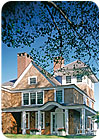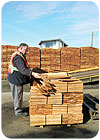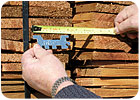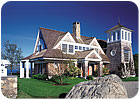Cedar Shakes and Shingles
Another busy roofing season is right around the corner. You take pride in delivering a quality job performed by trained crewmembers. The success formula is pretty obvious: quality products plus quality installation equals satisfied customers.

 Another busy roofing season is right around the corner. You take pride in delivering a quality job performed by trained crewmembers. The success formula is pretty obvious: quality products plus quality installation equals satisfied customers.
Another busy roofing season is right around the corner. You take pride in delivering a quality job performed by trained crewmembers. The success formula is pretty obvious: quality products plus quality installation equals satisfied customers.
Smart contractors know that nailing down more roofing jobs depends upon hard work, correct marketing and strong supplier relationships. Make the process much easier for yourself and your team by learning more about how to correctly specify inspected cedar shakes and shingles, and how to speak green.
Take the complication out of the sales process. Customers want Certi-label™ brand roofs. There are good reasons why this brand is specified in contracts across the nation: independent inspections, manufacturers’ quality commitment, as well as detailed labels.




Brindisi & Yaroscak Custom Builders Inc. Architect: George Dumitru.

Brindisi & Yaroscak Custom Builders Inc.Architect: Bartels Pagliaro Architects Photo: Olson Photographic.
Smart contractors know that nailing down more roofing jobs depends upon hard work, correct marketing and strong supplier relationships. Make the process much easier for yourself and your team by learning more about how to correctly specify inspected cedar shakes and shingles, and how to speak green.
Take the complication out of the sales process. Customers want Certi-label™ brand roofs. There are good reasons why this brand is specified in contracts across the nation: independent inspections, manufacturers’ quality commitment, as well as detailed labels.

Products manufactured by Cedar Shake & Shingle Bureau members must undergo independent third-party inspections by an accredited agency. (Photo courtesy of the Cedar Shake & Shingle Bureau. Photo by Kelly Vaille.)
Inspected by Accredited Agencies
Cedar Shake & Shingle Bureau member manufacturers’ products must undergo independent third-party inspections by an accredited agency. The inspection agency visits the mills unannounced and checks that products meet applicable grading standards. In addition, the Cedar Shake & Shingle Bureau has a Cedar Quality Auditor on staff that reviews the agency’s work by also inspecting the member mills’ products, providing an unprecedented second layer of quality checks for the consumer. The grading standards are stringent, authored by the Cedar Shake & Shingle Bureau, and are the building code standard for all cedar shake and shingle roofs throughout the United States and Canada. The current edition is called CSSB-97, and it is available from the CSSB (www.cedarbureau.org). Member mills realize how important quality is, and see that top quality products result in better, expanding markets and happier customers.
The inspection agency visits the mills unannounced and checks that products meet applicable grading standards. As part of the process, inspectors measure shake width with a gauge and check the shingle length. (Photo courtesy of the Cedar Shake & Shingle Bureau. Photo by Kelly Vaille.)
Labels on Each Bundle
Member products must have a label tucked under the band wire for each bundle produced. Bundles are grouped together, forming “squares” (a square is usually comprised of four bundles); each bundle must still be clearly identified with a label bearing a number of items. Some of the items on a label include:- Product grade, type and dimensions.
- Quality control agency logo.
- Mill name, location and phone number.
- Building code compliance numbers.
- Product performance tests passed.
- Coverage chart.

Photo by Robert Benson
Cedar Is Green
Do your boots leave a green footprint? Many homeowners expect their building products to be environmentally friendly. Yes, it’s a complicated subject and it’s best to learn some facts so you can address the topic efficiently and effectively. Putting a cedar roof on a home is making an environmentally sound choice. Forests play an important role in the earth’s carbon cycle, storing carbon and releasing oxygen through photosynthesis. Younger forests are the most efficient at taking in carbon; older forests at the end of their life cycle are much less efficient. Properly managed forests are known as helpful carbon sinks, which offset carbon emissions produced by numerous fossil fuel burning factories and cars. Studies show that wood conserves energy and minimizes pollution. On top of that, it’s a renewable resource and biodegradable. Sustainable harvesting practices are used in North American forests. Correct forest management techniques play a large role in preventing devastating wildfires that feed off debris cluttering forest floors. The Cedar Shake & Shingle Bureau has free, helpful publications to assist you with greening your discussions.Helping Your Business and Your Customers
These tips will speed up the cedar-roofing contract and jobsite progress:- Ensure you get what you pay for. Make sure you get the products you want and, if you don’t, talk to your supplier pronto. Specify correctly and in detail on the job order with your supplier. Specify the grade, product type and dimensions on the purchase order. If you only write “cedar shakes” on the purchase order, then you might just see a load of un-inspected, off-grade material show up on your jobsite. This creates installation delays and customer anxiety.
- Check the label carefully. Current building codes in the United States and Canada require independent third-party inspection of all wood shakes and shingles. If there is no third-party inspection stamp, the product may not meet code. Check with your local building official for more details.
- Check that you are getting roofing starter course delivered, not sidewall shingle undercoursing. There is a difference in grade between these two products.
- Do not accept documentation stating “shake shingle” products. In reality, there are two main kinds of shakes: (1) handsplit and resawn and (2) tapersawn. Shingles are another product category. Sloppy paperwork will lead to headaches down the road - so be forewarned.
- Be clear about any warranty requirements. These will include actual labels to send in with the contract and registration card. Be sure to discuss this with your client and also discuss the labels that will be needed, often including field, ridge and starter. Once the jobsite is cleaned up, it’s too late.
- Know current local building code. Code requirements vary by region and are critical to a successful roofing job. Ensure you are familiar with the correct product grade, type, fasteners (and be aware of cheap imitators from overseas), flashing, underlayment, etc., required in your local area. Knowledge failure in this area is not an option.
- Understand your customers’ “green” concerns. Let them know about sustainable forest harvesting practices and how wood conserves energy and minimizes pollution. Get the facts and be educated.
- Ask questions. There are many family-owned businesses in this industry, some going strong for their third and fourth generations. They welcome your questions, as does the Cedar Shake & Shingle Bureau. Industry stakeholders realize that with over 100 different types of cedar shakes and shingles, it can get confusing. Contact the Cedar Shake & Shingle Bureau for technical assistance, informative literature or to book a free educational seminar in various regions of the country.
Looking for a reprint of this article?
From high-res PDFs to custom plaques, order your copy today!



